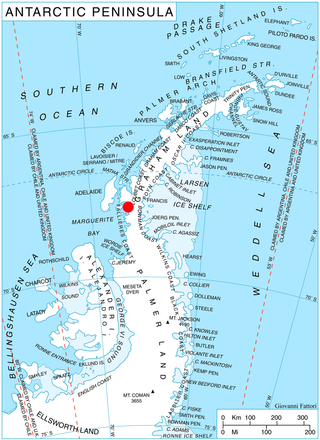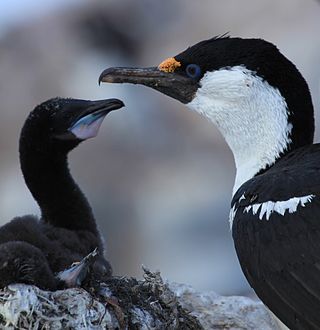Related Research Articles

Aagaard Glacier, also known as Glaciar Alderete, is an 8-mile (13 km) long Antarctic glacier which lies close to the east of Gould Glacier and flows in a southerly direction into Mill Inlet, on the east coast of Graham Land. It was charted by the Falkland Islands Dependencies Survey (FIDS) and photographed from the air by the Ronne Antarctic Research Expedition during December 1947; it was named by the FIDS for Bjarne Aagaard, a Norwegian authority on Antarctic whaling and exploration.
Athene Glacier is a glacier, 10 miles (16 km) long, flowing east and merging with the terminus of Casey Glacier where it discharges into Casey Inlet, on the east coast of the Antarctic Peninsula.

The Ambrose Rocks are a small cluster of rocks situated southwest of the southern Argentine Islands and 1 nautical mile (2 km) northwest of the Gaunt Rocks, off the west coast of Graham Land, Antarctica. They were named by the UK Antarctic Place-Names Committee for David A. Ambrose, a survey assistant of the Hydrographic Survey Unit from HMS Endurance working in this area in February 1969.

Bagshawe Glacier is a glacier which drains the northeast slopes of Mount Theodore and discharges into Lester Cove, Andvord Bay west of Mount Tsotsorkov, on the west coast of Graham Land, Antarctica.
The Barros Rocks are a group of rocks between the Berthelot Islands and the Argentine Islands, lying 2 nautical miles (4 km) southwest of Cape Tuxen off the west coast of Graham Land. They were discovered by the French Antarctic Expedition, 1908–10, under Jean-Baptiste Charcot, and named after Captain Barros Cobra, a Brazilian naval officer at Rio de Janeiro, who assisted the expedition.

Chavez Island is an island 3 nautical miles (6 km) long which rises to 550 metres (1,800 ft), lying immediately west of Magnier Peninsula, which is between Leroux Bay and Bigo Bay, off the west coast of Graham Land. It was discovered and named by the French Antarctic Expedition, 1908–10, under Jean-Baptiste Charcot, probably for Commandant Alfonso Chaves of Ponta Delgada, Azores, but the spelling Chavez has become established through long usage.
Krebs Glacier is a glacier flowing west into the head of Charlotte Bay on the west coast of Graham Land, Antarctica. It was charted by the Belgian Antarctic Expedition under Gerlache, 1897–99, and was named by the UK Antarctic Place-Names Committee in 1960 for Arthur Constantin Krebs, who, with Charles Renard, constructed and flew the first dirigible airship capable of steady flight under control, in 1884.
The Kuberry Rocks are a small area of exposed rock at the north end of the Coulter Heights. The rocks are 6 nautical miles (11 km) northwest of Matikonis Peak, near the coast of Marie Byrd Land, Antarctica. They were mapped by the United States Geological Survey from surveys and U.S. Navy air photos, 1959–65, and were named by the Advisory Committee on Antarctic Names for Richard W. Kuberry, a geomagnetist/seismologist at Byrd Station, 1969–70.

Suárez Glacier also known as Petzval Glacier is a glacier flowing into the small cove between Skontorp Cove and Sturm Cove on the west coast of Graham Land. It was first mapped by Scottish geologist David Ferguson in 1913–14. The 5th Chilean Antarctic Expedition (1950–51) remapped it and named it for Lieutenant Commander Francisco Suárez V., Operations Officer on the transport ship Angamos.
The Frost Rocks are a cluster of rocks situated southwest of the southern Argentine Islands and 0.5 nautical miles (1 km) southwest of the Whiting Rocks, off the coast of Graham Land, Antarctica. They were named by the UK Antarctic Place-Names Committee for Richard Frost, a survey assistant of the Hydrographic Survey Unit from HMS Endurance working in the area in February 1969.
The Duparc Rocks are a group of rocks between 1 and 2 nautical miles off the coast, 3 nautical miles (6 km) northeast of Cape Roquemaurel, Trinity Peninsula. They were mapped from surveys by the Falkland Islands Dependencies Survey (1960–61), and were named by the UK Antarctic Place-Names Committee for Louis Duparc, a French naval officer on the Astrolabe during her Antarctic voyage (1837–1840).
Patience Rocks is a group of rocks lying 1.5 nautical miles (2.8 km) northwest of Avian Island, close off the south end of Adelaide Island. Named by the United Kingdom Antarctic Place-Names Committee (UK-APC) for Leading Engineer Mechanic Donald Patience, a member of the Royal Navy Hydrographic Survey Unit which charted this area in 1963.

The Pearl Rocks are a group of rocks covering an area 6 km (3.7 mi) by 4 km (2.5 mi) close to the west coast of Tower Island in the Palmer Archipelago of Antarctica. The name was given by Falkland Islands and Dependencies Aerial Survey Expedition (FIDASE) (1955–57) and is descriptive of the numerous snow-covered rocks in the group.
Flank Island is the southernmost of the Myriad Islands, lying 2 nautical miles (4 km) east-northeast of the Snag Rocks in the Wilhelm Archipelago. It was mapped by the Falkland Islands Dependencies Survey from photos taken by Hunting Aerosurveys Ltd in 1956–57 and from the helicopter of HMS Protector in March 1958, and was named by the UK Antarctic Place-Names Committee because of its position.
The Gaunt Rocks are a small group of rocks lying 2 nautical miles (4 km) west of the Barros Rocks, in the Wilhelm Archipelago. They were roughly charted by the British Graham Land Expedition under John Rymill, 1934–37, and more accurately positioned by the Falkland Islands Dependencies Survey from photos taken by Hunting Aerosurveys Ltd in 1956–57. The name, given by the UK Antarctic Place-Names Committee in 1959, is descriptive of these desolate, grim-looking rocks.
Miethe Glacier is a glacier 3 nautical miles (6 km) long, flowing northwest into Gerlache Strait to the south of Mount Banck, on the west coast of Graham Land, Antarctica. The glacier appears on an Argentine government chart of 1952. It was named by the UK Antarctic Place-Names Committee in 1960 for Adolf Miethe, a German chemist who introduced the first panchromatic emulsion for photographic plates in 1903.

Hektoria Glacier is a glacier flowing south from the area around Mount Johnston between Mount Quandary and Zagreus Ridge into Vaughan Inlet next west of Brenitsa Glacier and east of Green Glacier, on the east coast of the Antarctic Peninsula.
The Huddle Rocks are a group of rocks lying 1.5 nautical miles (3 km) northwest of the Symington Islands, in the Biscoe Islands of Antarctica. They were mapped by the Falkland Islands Dependencies Survey from photos taken by Hunting Aerosurveys Ltd in 1956–57, and so named by the UK Antarctic Place-Names Committee because of the compact nature of the group.
Manciple Island is an island lying between Reeve Island and Host Island in the Wauwermans Islands, in the Wilhelm Archipelago of Antarctica. It was shown on an Argentine government chart of 1952. The island was named by the UK Antarctic Place-Names Committee in 1958 after the Manciple, one of the characters in Geoffrey Chaucer's The Canterbury Tales.
Launch Rock is a submerged rock lying southwest of the Glover Rocks, off the south end of Adelaide Island, Antarctica. It was named by the UK Antarctic Place-Names Committee to commemorate the unnamed launch from RRS John Biscoe that was used by the Hydrographic Survey Unit which charted this area in 1963.
References
- ↑ "Lorn Rocks". Geographic Names Information System . United States Geological Survey, United States Department of the Interior . Retrieved 3 July 2013.
![]() This article incorporates public domain material from "Lorn Rocks". Geographic Names Information System . United States Geological Survey.
This article incorporates public domain material from "Lorn Rocks". Geographic Names Information System . United States Geological Survey.
